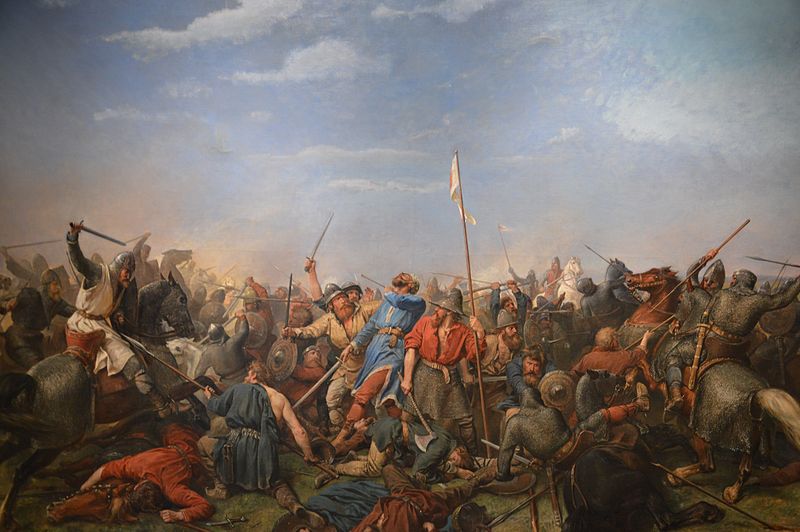Edward the Confessor, King of England, went into a coma in late 1065, having expressed no clear preference for a successor. Edward died on January 5, 1066, after briefly regaining consciousness and commending his wife and kingdom to the “protection” of Harold, son of Godwin, the powerful Earl of Essex.
Anglo-Saxon Kings didn’t ordinarily pick their own successors, but their wishes carried import. Nobles of the Witenagemot, the early Anglo-Saxon predecessor to the modern parliament, appear to have been in Westminster to observe the Feast of the Epiphany. Convening the following day, the council elected Harold Godwinson, crowning him King Harold II.
For some, Harold’s quick ascension was a matter of administrative convenience and happenstance. Others saw it as evidence of conspiracy. A usurpation of the throne. Edward’s death touched off a succession crisis that would change world history.
Harold’s younger brother Tostig, Earl of Northumbria, believed he had his own claim to the throne. His animosity for his brother would prove fatal for them both. After conducting inconclusive raids that spring, Tostig went to a Norman Duke called William “the Bastard”, looking for support. William had his own claim to the English throne, and had openly declared his intention to take it. The Norman Duke had no use for King Harold’s little brother, so Tostig sought the assistance of the King of Norway, King Harald “Hardraada”, the name translating, literally, as “hard ruler”.
 Tostig sailed for England with King Harald and a mighty army of 10,000 Viking warriors, meeting the northern Earls Edwin and Morcar in battle at Fulford Gate, on September 20.
Tostig sailed for England with King Harald and a mighty army of 10,000 Viking warriors, meeting the northern Earls Edwin and Morcar in battle at Fulford Gate, on September 20.
The encounter was a comprehensive defeat for the English side. When Harald came to Stamford Bridge five days later, he expected only formal capitulation and tribute.
Meanwhile, King Harold was at the head of an army in the south, anticipating William’s invasion from Normandy. My military friends will appreciate what happened next; Harold marched his army north, traveling day and night, covering 185 miles in four days, on foot, completely surprising the Viking army waiting at Stamford Bridge.
The Vikings must have looked at the horizon and wondered how a peace party could raise that much dust, only to learn that they faced a new army.
Believing they were there to accept submission, Harald’s army had left half its number behind to watch the ships, along with their armor.

During the height of the following battle, one giant Viking warrior, a Berserker, stood alone at the top of Stamford Bridge. Swinging the great two-handed Dane Axe, this giant of a man had slain something like 40 English warriors, lying dead in heaps around him, when one of Harold’s soldiers floated himself under the bridge, spearing the Viking warrior from below.
The savagery of the battle can only be imagined. Before the age of industrialized warfare, every injury was personally administered with a bladed or crushing weapon of some kind. 5,000 of King Harold’s soldiers would be dead before it was over, about a third of his force. Two thirds of King Harald’s Vikings died that day, about 6,000, including Harald himself and his ally Tostig. So many died in that small area that 50 years later, the site was said to have turned white with the sun bleached bones of the slain.
Of some 300 ships arriving on the 20th, the battered remnants of Harald’s Viking army needed only 24, to sail away.
Stamford Bridge is often described as the end of the Viking invasions of England, but that isn’t quite so. There would be others, but none so powerful as this.
The Norman landing King Harold had been waiting for took place three days later at Pevensey Harbor, just as his battered army was disbanding and heading home for the Fall harvest. The Anglo Saxon army would march south again, meeting the Norman invader on October 14 at a place called “Hastings”. King Harold II took an arrow in the eye that day, thus becoming the last of the Anglo Saxon Kings.

Thenceforward and forever, William the Bastard would be known as William “The Conqueror”.



I took this story to the next chapter this morning, Mike, making this one about the Domesday book. As always, I hope I got the story right. On this particular one, I anxiously await your comments.
LikeLike
Love the map!
LikeLiked by 1 person